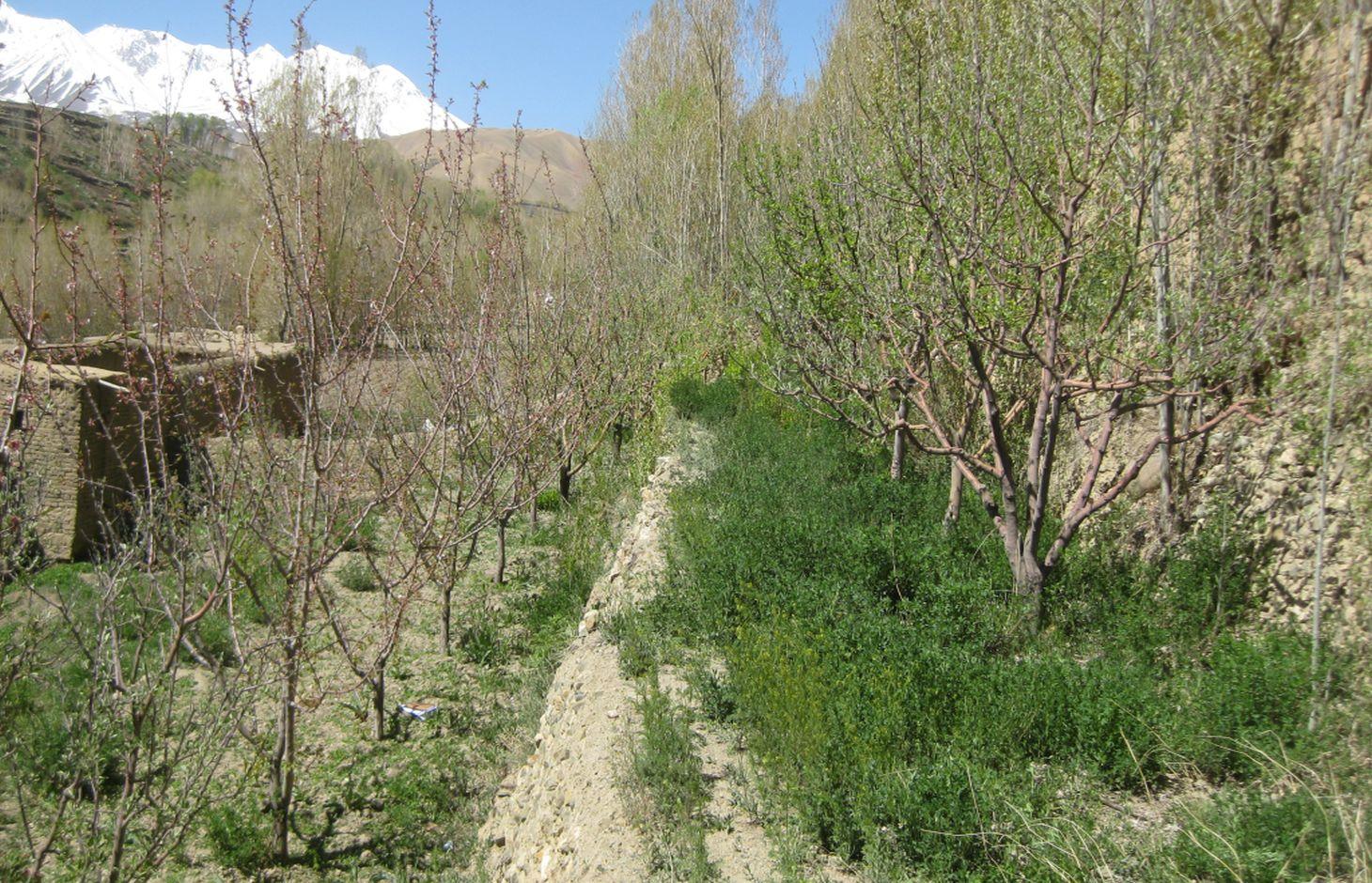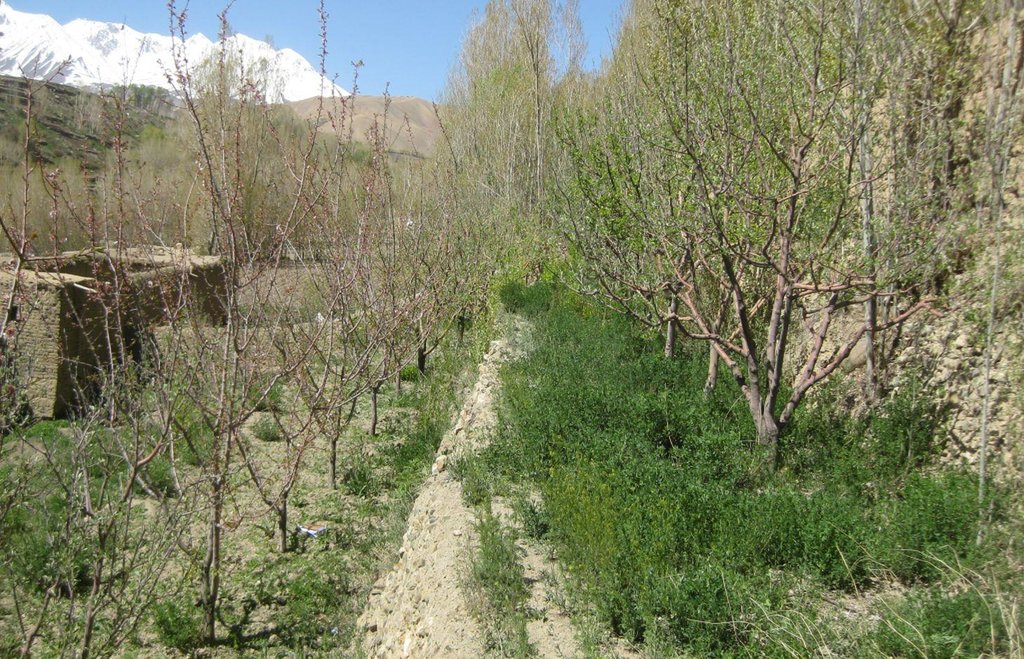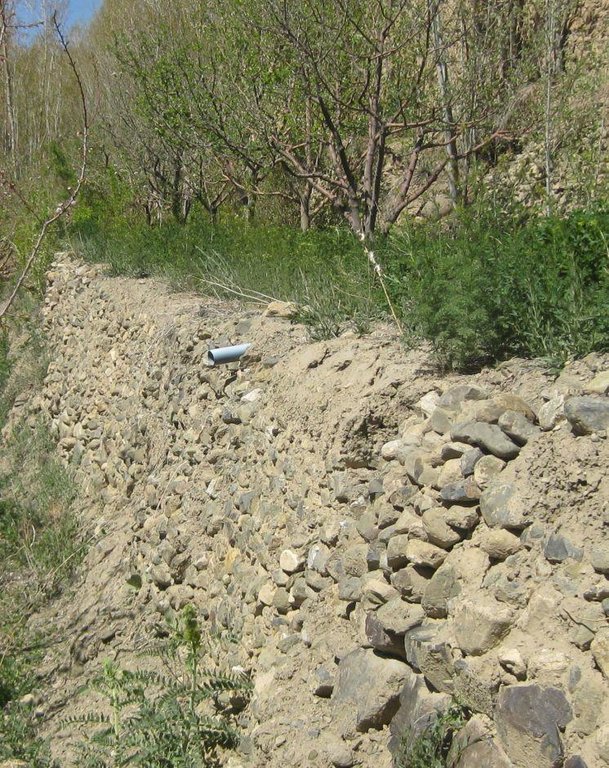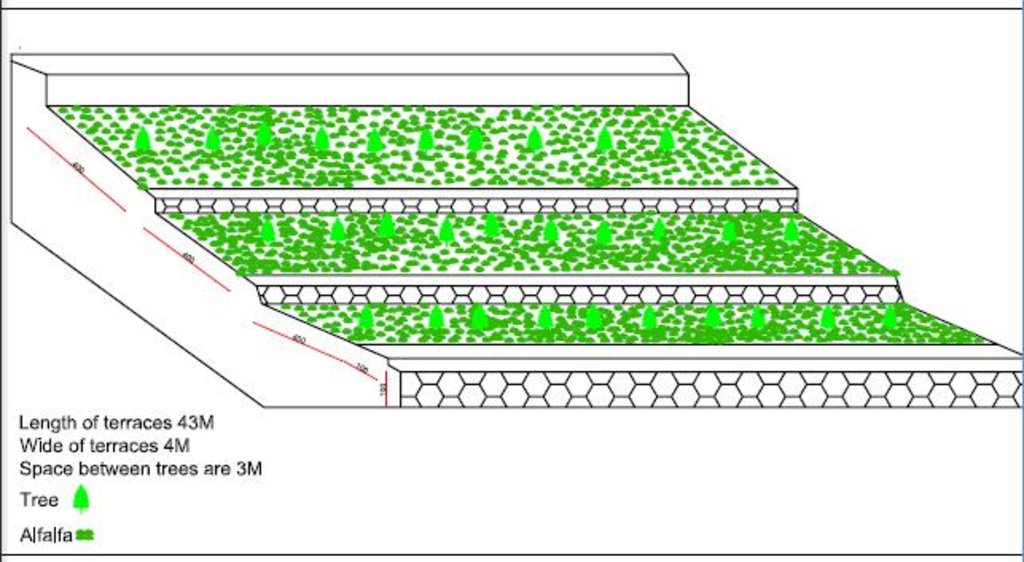Alfalfa intercropping in terraced fruit orchard [Afghanistan]
- Creation:
- Update:
- Compiler: Aqila Haidery
- Editor: –
- Reviewer: David Streiff
Baghe Tabaqabandi
technologies_1198 - Afghanistan
View sections
Expand all Collapse all1. General information
1.2 Contact details of resource persons and institutions involved in the assessment and documentation of the Technology
SLM specialist:
SLM specialist:
SLM specialist:
SLM specialist:
SLM specialist:
Sthapit Keshar
HELVETAS Swiss Intercooperation
Name of the institution(s) which facilitated the documentation/ evaluation of the Technology (if relevant)
HELVETAS (Swiss Intercooperation)1.3 Conditions regarding the use of data documented through WOCAT
When were the data compiled (in the field)?
16/05/2014
The compiler and key resource person(s) accept the conditions regarding the use of data documented through WOCAT:
Ja
2. Description of the SLM Technology
2.1 Short description of the Technology
Definition of the Technology:
Terraced orchard with alfalfa cultivation for fruit and fodder production and soil and water conservation.
2.2 Detailed description of the Technology
Description:
The Alfalfa inter-cropping in terraced fruit orchard technology is documented by Sustainable Land Management Project/HELVETAS Swiss Intercooperation with financial support of Swiss Agency for Development and Cooperation (SDC).
In the semi-arid regions of the Central Highlands in Afghanistan, land is intensively used for the
cultivation of subsistence (wheat) and cash crops. The technology presented here provides an economically sound solution for soil and water conservation. In this example, Alfalfa is grown in the spaces between the young trees to make use of the soil, light and water. The soil and water conservation quality of the technology is further enhanced with terracing to capture water.
Purpose of the Technology: The main purpose of establishing the fruit orchard with Alfalfa was to produce fruits for both
consumption and income, as well as for animal fodder. Terraces are important for retaining soil moisture, reducing soil erosion and preventing nutrient leaching. Alfalfa increases soil fertility as it fixes
nitrogen.
Establishment / maintenance activities and inputs: The area under this specific technology is less than 0.03 ha. The technology was established by the land user five years ago without external support. In the past, the site was sloping agriculture land used for potato and wheat cultivation, the two major staple crops in Bamyan. Animal manure, with small quantities of chemical fertilizers, were used to maintain the soil fertility. The farmer, Haji Hussain, learning from similar examples from Kabul, applied this technology on his private land
with sight modifications by including terraces for soil and water conservation. For the construction of one terrace, 14 person days are needed. The size of one terrace was about 43 m in length and 4 m in width.Initially the terraces were used for vegetable cultivation. Later on, he planted mainly apple and apricot trees and a few saplings of pear and plum. Two varieties of apple (red and yellow) were planted in the orchard and the distance between two trees in a row was about 3 m (for more details, please see the technical drawing). The saplings were prepared by the farmer himself using grafting. The trees vary in age, from 3-5 years. Alfalfa was planted 1-3 years ago. The farmer applies 1 kg urea and DAP per tree every spring in addition to a small quantities of manure. The orchard requires irrigation almost every week from mid-spring to autumn from a nearby canal. The water distribution and operation and maintenance of the irrigation infrastructure is regulated by a Mirab, or “Water Master”, elected by the water users and farmers.
Natural / human environment: Bamyan Center has temperate and semi-arid climate with an average annual rainfall of about 230 mm. The area receives snow during the winter season and the temperature can drop below -20 degree centigrade.There is one growing season from April to September. The soil in the orchard is sandy loam with moderate soil fertility. Orchards are considered to be more profitable by the land user than growing crops like wheat and potato. Before applying this technology, the average annual income of the owner from 0.3 ha land was 9,000 Afghani, equivalent to approx 180 USD. While after the application of terraced orchard with Alfalfa cultivation technology, his average annual income from 0.3 ha increased to 45000 Afghani or 900 USD.
2.3 Photos of the Technology
2.5 Country/ region/ locations where the Technology has been applied and which are covered by this assessment
Country:
Afghanistan
Region/ State/ Province:
Bamyan
Further specification of location:
Bamyan Centre / Shinya Fuladi
2.6 Date of implementation
If precise year is not known, indicate approximate date:
- 10-50 years ago
2.7 Introduction of the Technology
Specify how the Technology was introduced:
- through land users' innovation
Comments (type of project, etc.):
The farmers learnt this technology by seeing others apply it.
3. Classification of the SLM Technology
3.1 Main purpose(s) of the Technology
- improve production
- reduce, prevent, restore land degradation
- create beneficial economic impact
3.2 Current land use type(s) where the Technology is applied

Cropland
- Annual cropping
- Perennial (non-woody) cropping
- Tree and shrub cropping
Main crops (cash and food crops):
major cash crop: Apple and Apricot
major food crop: Wheat and Potato
other: Alfalfa

Grazing land
Intensive grazing/ fodder production:
- Cut-and-carry/ zero grazing
- Improved pastures
Comments:
Major land use problems (compiler’s opinion): In the past, the orchard site was a sloping land and used for cultivating wheat and potato without soil and water conservation measures. This resulted in soil erosion, soil fertility decline and low crop production.
Major land use problems (land users’ perception): Due to sloping land, most of the animal manure applied to the crops used to get leached affecting crop production.
Future (final) land use (after implementation of SLM Technology): Cropland: Ct: Tree and shrub cropping
If land use has changed due to the implementation of the Technology, indicate land use before implementation of the Technology:
Cropland: Ca: Annual cropping
3.3 Further information about land use
Water supply for the land on which the Technology is applied:
- full irrigation
Number of growing seasons per year:
- 1
Specify:
Longest growing period in days: 180; Longest growing period from month to month: April-September
3.4 SLM group to which the Technology belongs
- rotational systems (crop rotation, fallows, shifting cultivation)
- cross-slope measure
3.5 Spread of the Technology
Comments:
Total area covered by the SLM Technology is 0.0003 km2.
Alfalfa is cultivated in apple and apricot mixed terraced orchard for multiple benefits.
3.6 SLM measures comprising the Technology

vegetative measures
- V5: Others

structural measures
- S1: Terraces
Comments:
Specification of other vegetative measures: fruit trees and alfalfa
Type of vegetative measures: aligned: -linear, scattered / dispersed
3.7 Main types of land degradation addressed by the Technology

soil erosion by water
- Wt: loss of topsoil/ surface erosion

chemical soil deterioration
- Cn: fertility decline and reduced organic matter content (not caused by erosion)
Comments:
Main type of degradation addressed: Wt: loss of topsoil / surface erosion, Cn: fertility decline and reduced organic matter content
Main causes of degradation: soil management (Agriculure on sloping land without conservation measures), disturbance of water cycle (infiltration / runoff) (Due to sloping land), education, access to knowledge and support services (Lack of knowledge about sloping agriculture land soil and water conservation technologies)
3.8 Prevention, reduction, or restoration of land degradation
Specify the goal of the Technology with regard to land degradation:
- reduce land degradation
4. Technical specifications, implementation activities, inputs, and costs
4.1 Technical drawing of the Technology
4.2 Technical specifications/ explanations of technical drawing
Layout of the terraced fruit orchard with alfalfa crop.
Location: Shenya, Foladi valley. Bamyan
Date: 14.06.2016
Technical knowledge required for land users: moderate
Main technical functions: control of dispersed runoff: impede / retard, reduction of slope angle, reduction of slope length, improvement of ground cover, promotion of vegetation species and varieties (quality, eg palatable fodder)
Aligned: -linear
Vegetative material: F : fruit trees / shrubs
Number of plants per (ha): 800
Vertical interval between rows / strips / blocks (m): 1
Spacing between rows / strips / blocks (m): 1.3
Vertical interval within rows / strips / blocks (m): 2.5
Scattered / dispersed
Vegetative material: C : perennial crops
Width within rows / strips / blocks (m): 3.5
Trees/ shrubs species: Apple and Apricot
Perennial crops species: Alfalfa
If the original slope has changed as a result of the Technology, the slope today is (see figure below): 2%
Terrace: bench level
Width of bunds/banks/others (m): 4
Length of bunds/banks/others (m): 43
Bund/ bank: graded
Vertical interval between structures (m): 1
Spacing between structures (m): 1.3
Construction material (earth): for making terraces
Construction material (stone): for making risers
If the original slope has changed as a result of the Technology, the slope today is: 2%
Change of land use type: Conversion of annual cropland into perennial fruit orchard with perennial fodder crop
4.3 General information regarding the calculation of inputs and costs
other/ national currency (specify):
Afghani
Indicate exchange rate from USD to local currency (if relevant): 1 USD =:
57.0
Indicate average wage cost of hired labour per day:
400
4.4 Establishment activities
| Activity | Type of measure | Timing | |
|---|---|---|---|
| 1. | Plantation of saplings | Vegetative | Late Autumn or early spring |
| 2. | Plantation of alfalfa | Vegetative | early spring |
| 3. | Construction of terraces | Structural | Dry season |
4.5 Costs and inputs needed for establishment
| Specify input | Unit | Quantity | Costs per Unit | Total costs per input | % of costs borne by land users | |
|---|---|---|---|---|---|---|
| Labour | Construction of terraces | persons/day/ha | 400.0 | 400.0 | 160000.0 | 100.0 |
| Plant material | Plantation of saplings | pieces/ha | 800.0 | 150.0 | 120000.0 | 100.0 |
| Plant material | Plantation of alfalfa | kg/ha | 100.0 | 250.0 | 25000.0 | 100.0 |
| Total costs for establishment of the Technology | 305000.0 | |||||
4.6 Maintenance/ recurrent activities
| Activity | Type of measure | Timing/ frequency | |
|---|---|---|---|
| 1. | Fertilizer application only | Vegetative | Spring |
4.7 Costs and inputs needed for maintenance/ recurrent activities (per year)
| Specify input | Unit | Quantity | Costs per Unit | Total costs per input | % of costs borne by land users | |
|---|---|---|---|---|---|---|
| Fertilizers and biocides | Fertilizer application only | kg/ha | 800.0 | 16.0 | 12800.0 | 100.0 |
| Total costs for maintenance of the Technology | 12800.0 | |||||
Comments:
The costs are extrapolated for 1 ha. Current (2014) labour and currency exchange rates were used for calculations.
4.8 Most important factors affecting the costs
Describe the most determinate factors affecting the costs:
Labour for construction work is the most determinate factor affection costs.
5. Natural and human environment
5.1 Climate
Annual rainfall
- < 250 mm
- 251-500 mm
- 501-750 mm
- 751-1,000 mm
- 1,001-1,500 mm
- 1,501-2,000 mm
- 2,001-3,000 mm
- 3,001-4,000 mm
- > 4,000 mm
Specify average annual rainfall (if known), in mm:
230.00
Specifications/ comments on rainfall:
Most rainfall is recorded in the months of April and May. Rainy season begins in April and ends in June.
Agro-climatic zone
- semi-arid
Thermal climate class: temperate. Temperatures can drop to below -22 degree centigrade
5.2 Topography
Slopes on average:
- flat (0-2%)
- gentle (3-5%)
- moderate (6-10%)
- rolling (11-15%)
- hilly (16-30%)
- steep (31-60%)
- very steep (>60%)
Landforms:
- plateau/plains
- ridges
- mountain slopes
- hill slopes
- footslopes
- valley floors
Altitudinal zone:
- 0-100 m a.s.l.
- 101-500 m a.s.l.
- 501-1,000 m a.s.l.
- 1,001-1,500 m a.s.l.
- 1,501-2,000 m a.s.l.
- 2,001-2,500 m a.s.l.
- 2,501-3,000 m a.s.l.
- 3,001-4,000 m a.s.l.
- > 4,000 m a.s.l.
Comments and further specifications on topography:
Landforms: Level terraces
Altitudinal zone: About 2600 m above mean sea level
5.3 Soils
Soil depth on average:
- very shallow (0-20 cm)
- shallow (21-50 cm)
- moderately deep (51-80 cm)
- deep (81-120 cm)
- very deep (> 120 cm)
Soil texture (topsoil):
- coarse/ light (sandy)
- medium (loamy, silty)
Topsoil organic matter:
- medium (1-3%)
If available, attach full soil description or specify the available information, e.g. soil type, soil PH/ acidity, Cation Exchange Capacity, nitrogen, salinity etc.
Soil fertility is medium due to use of manure, fertilizer and also alfalfa
Soil drainage / infiltration is good due to vegetation
Soil water storage capacity is medium
5.4 Water availability and quality
Ground water table:
5-50 m
Availability of surface water:
good
Water quality (untreated):
for agricultural use only (irrigation)
Comments and further specifications on water quality and quantity:
Availability of surface water: Access to irrigation water canal
Water quality (untreated): From the canal.
5.5 Biodiversity
Species diversity:
- low
5.6 Characteristics of land users applying the Technology
Market orientation of production system:
- mixed (subsistence/ commercial
Off-farm income:
- 10-50% of all income
Relative level of wealth:
- rich
Individuals or groups:
- individual/ household
Level of mechanization:
- manual work
Gender:
- men
Indicate other relevant characteristics of the land users:
Land users applying the Technology are mainly common / average land users
Difference in the involvement of women and men: Many works concerning orchard maintenance and harvesting are done by women as well.
Population density: 10-50 persons/km2
Annual population growth: 2% - 3%
Off-farm income specification: Mainly land users with large irrigated agriculture land holdings. The majority of the population has less than 1 ha land thus off-farm income seems to be very important.
Level of mechanization: He performed with his son and family
5.7 Average area of land owned or leased by land users applying the Technology
- < 0.5 ha
- 0.5-1 ha
- 1-2 ha
- 2-5 ha
- 5-15 ha
- 15-50 ha
- 50-100 ha
- 100-500 ha
- 500-1,000 ha
- 1,000-10,000 ha
- > 10,000 ha
Is this considered small-, medium- or large-scale (referring to local context)?
- large-scale
Comments:
2-5 ha: This applies to a very small extent of the population like this land user
5.8 Land ownership, land use rights, and water use rights
Land ownership:
- individual, titled
Land use rights:
- individual
Water use rights:
- communal (organized)
Comments:
Water use rights are common and organised. The village has access to sufficient irrigation water throughout the year.
5.9 Access to services and infrastructure
health:
- poor
- moderate
- good
education:
- poor
- moderate
- good
technical assistance:
- poor
- moderate
- good
employment (e.g. off-farm):
- poor
- moderate
- good
markets:
- poor
- moderate
- good
energy:
- poor
- moderate
- good
roads and transport:
- poor
- moderate
- good
drinking water and sanitation:
- poor
- moderate
- good
financial services:
- poor
- moderate
- good
6. Impacts and concluding statements
6.1 On-site impacts the Technology has shown
Socio-economic impacts
Production
crop production
Quantity before SLM:
0
Quantity after SLM:
420 kg
Comments/ specify:
Fruit production
fodder production
Comments/ specify:
Alfalfa
fodder quality
Comments/ specify:
Alfalfa
animal production
Comments/ specify:
Due to alfalfa consumption
energy generation
Comments/ specify:
Pruned twigs can be used for firewood
Income and costs
farm income
Quantity before SLM:
10,000 Afghani
Quantity after SLM:
45,000 Afghani
Socio-cultural impacts
food security/ self-sufficiency
Comments/ specify:
Due to more income and production
recreational opportunities
Comments/ specify:
Due to greenery and sound of birds.
SLM/ land degradation knowledge
Comments/ specify:
Farmer to farmer knowledge exchange
livelihood and human well-being
Comments/ specify:
The technology help in increased income which can be used for buying food. Families consume more and a greater variety of foods which is beneficial for health.
Ecological impacts
Soil
soil cover
soil loss
Biodiversity: vegetation, animals
plant diversity
Comments/ specify:
More species, cultivated and natural
animal diversity
Comments/ specify:
E.g. Birds
6.2 Off-site impacts the Technology has shown
groundwater/ river pollution
buffering/ filtering capacity
6.3 Exposure and sensitivity of the Technology to gradual climate change and climate-related extremes/ disasters (as perceived by land users)
Gradual climate change
Gradual climate change
| Season | Type of climatic change/ extreme | How does the Technology cope with it? | |
|---|---|---|---|
| annual temperature | increase | not known |
Other climate-related consequences
Other climate-related consequences
| How does the Technology cope with it? | |
|---|---|
| Fruit tress are sensitive to frost | not well |
6.4 Cost-benefit analysis
How do the benefits compare with the establishment costs (from land users’ perspective)?
Short-term returns:
negative
Long-term returns:
very positive
How do the benefits compare with the maintenance/ recurrent costs (from land users' perspective)?
Short-term returns:
slightly negative
Long-term returns:
very positive
6.5 Adoption of the Technology
- single cases/ experimental
If available, quantify (no. of households and/ or area covered):
1 household
Of all those who have adopted the Technology, how many have did so spontaneously, i.e. without receiving any material incentives/ payments?
- 90-100%
Comments:
1 land user families have adopted the Technology without any external material support
Comments on spontaneous adoption: There are other 20 land user families in the region who has applied this technology.
There is a little trend towards spontaneous adoption of the Technology
Comments on adoption trend: There is a small but growing trend towards spontaneous adoption of the technology among farmers with access to irrigated lands.
6.7 Strengths/ advantages/ opportunities of the Technology
| Strengths/ advantages/ opportunities in the land user’s view |
|---|
|
The technology has multiple benefits and needs less labour inputs. How can they be sustained / enhanced? The technology system can be enhanced by including honeybee keeping. |
| Strengths/ advantages/ opportunities in the compiler’s or other key resource person’s view |
|---|
|
Reduced soil erosion and improved water management compared to sloping agricultural land. How can they be sustained / enhanced? Efficient use of water by the application of mulching and pitcher irrigation. Use of well decomposed compost for increasing production and reinforcement of soil quality. Reduced usage of chemical fertilizer. |
|
The technology can be easily applied. How can they be sustained / enhanced? Exposure visit of farmers to improved orchard cultivation practices. |
|
Including perennial fodder crop like alfalfa has multiple benefits. How can they be sustained / enhanced? Alalfa is a water demanding crop. Other nitrogen perennial high quality perennial crops like sainfoin could be tried by the farmer. |
|
The demand for fruits is high, therefore, it contributes to the increased income of the farmers. How can they be sustained / enhanced? Production could be increased through better orchard management. Farmers may need training and information on improved methods through agriculture extension departments and concerned non-governmental organisations. |
6.8 Weaknesses/ disadvantages/ risks of the Technology and ways of overcoming them
| Weaknesses/ disadvantages/ risks in the land user’s view | How can they be overcome? |
|---|---|
| Fruit trees are sensitive to frost. | Relevant research organisations need to develop tolerant varieties through participatory technology approach. Sharing better practices from other countries may be useful. |
| Weaknesses/ disadvantages/ risks in the compiler’s or other key resource person’s view | How can they be overcome? |
|---|---|
| The technology depends on a constant supply of irrigation water. | Demonstration of improved orchards with a focus on water conservation and soil nutrient management (use of compost, mulch, pitcher irrigation, etc.) |
Links and modules
Expand all Collapse allLinks
No links
Modules
No modules





